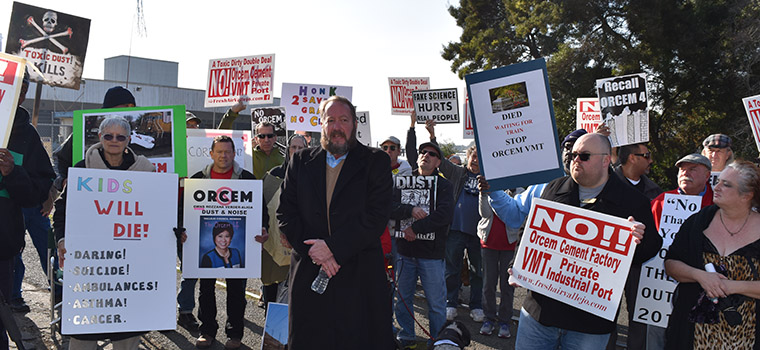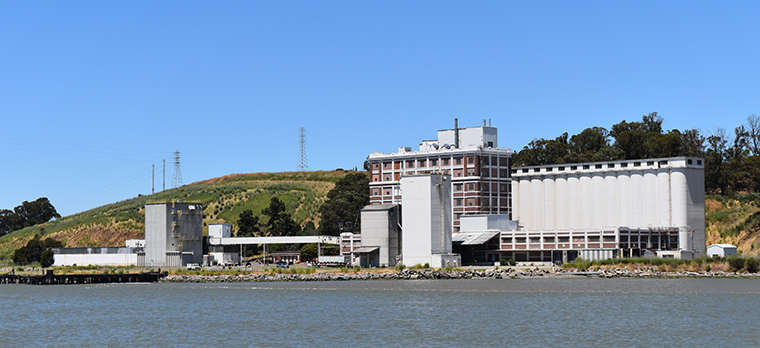On the morning of Wednesday, December 13, a group of people gathered in Vallejo who oppose the building of a cement plant and deep water port on the shores of Vallejo near the entrance of the Mare Island Strait.

Jay Gunkelman addresses a group of people gathered in front of the old General Mills location on Vallejo’s waterfront. The proposed location of a controversial new cement factory run by Irish company Orcem. Photo by Joel Williams
BY JOEL WILLIAMS
Published: January, 2018
On the morning of Wednesday, December 13, a group of people gathered in Vallejo who oppose the building of a cement plant and deep water port on the shores of Vallejo near the entrance of the Mare Island Strait. They met at the location of the proposed project that has been a point of contention with Vallejo residents since a draft environmental impact report (DEIR) was released in September 2015.
They were there to hear from an independent expert on clean air who claims that the data used by Orcem is wrong and sometimes even fraudulent. Jay Gunkelman, who was on the Community Air Quality Monitoring Technology Advisory Panel for the Bay Area Air Quality Management District, called the news conference to present his findings.
Gunkelman, a Vallejo resident who has been involved in environmental advocacy for over 25 years, said that he was surprised that the DEIR submitted by Orcem essentially shows that the plant would not have a major impact on the surrounding area.
“I couldn’t imagine how that could be,” Gunkelman said. “I dug into their environmental impact report in detail and I found that they used fraudulent science. I’m not saying they made a mistake. They submitted this under penalty of perjury and what they did was deliberate.”
Gunkelman gave several highly technical examples of issues that he claims were not correctly calculated in the DEIR. He believes that if the actual health risk hazard was included in the report, the plant couldn’t be built within a mile and a half to two miles of anybody’s home.
The findings from his research into the report included:
• The Orcem cement mill would emit dangerous levels of toxic emissions.
• The Orcem cement mill would cause dangerous levels of cement dust to escape into the neighborhood.
• The Orcem cement mill would emit hazardous materials that are known to cause cancer.
Another major issue that Gunkelman brought up was that the model used in the report was for a rural deposition, when the location clearly does not meet the guidelines for modeling as rural. He also asserted that what he saw in the report cannot be categorized as a mistake here and there, but that everything was systematically tweaked in the company’s favor.
“I call it fraud,” Gunkelman said. “They could sue me for saying that they are fraudulent. Please do! If you go to court, you get discovery and interrogatories would be really fun on this one.”
On several occasions Gunkelman offered to meet face-to-face with the scientists that were used to create the Orcem report to defend all of his claims publicly. “I’m willing to pay for the scientists to come and go toe-to-toe. How often do you get a fighter paying for their opposition to show up?”
The cement factory project, proposed by the Irish company Orcem and the local Vallejo Marine Terminal LLC (VMT), has been plagued by long-term controversy. In early 2016, reports surfaced that Orcem CEO Steven Bryan let it slip during a town hall-style meeting at an African-American church that Orcem and VMT had been meeting privately with members of the city council for almost two years to move the plan along before the public was even aware of the project.
The Vallejo Times-Herald reported at the time that council member Jess Malgapo had expressed apparent support for the project on numerous occasions and chaired the Mare Island Straits Economic Development Committee (MISEDC), a group formed in April 2014 to explore dredging the strait for economic development and “gain traction” for the Orcem/VMT project.
In March of this year, after hours of public comments and much debate, the project was voted down six to one by the City of Vallejo Planning Commission, with at least one member saying that the comments received from the community were 10 to one in opposition to the waterfront cement plant. All that was left was for the Vallejo City Council to follow suit when Orcem/VMT appealed the decision.
At a council meeting in June, however, all of the council members that participated in the MISEDC meetings—Jess Malgapo, Rozzana Verder-Aliga and Pippin Dew-Costa, along with Herme Sunga (elected in 2016)—ignored the planning commission’s decision and voted to continue the process. They directed city staff to work with Orcem/VMT on finalizing the impact report, earning them the moniker the “Orcem Four.”
“There’s four people on the city council that allowed this to move forward,” said Gunkelman, “The ‘Orcem Four’ need to be challenged. They voted the way they did based on bad science.” He went on to say that with this new information, those members may now have a reason to change their thinking. “We’ve given them an excuse to change their mind and it’s a good excuse: science.”
“Our scientific analysis of the Orcem cement factory shows that air pollution levels will be too high. The homes and school in this neighborhood would suffer from an illegal and immoral amount of diesel exhaust and cement dust,” said Gunkelman. “Nowhere else has Orcem built a cement factory so close to a residential neighborhood. Orcem told us there would be no air pollution, but now we know that is not true. Orcem can no longer hide. If there was ever a plant that shouldn’t be built, this is it. The City of Vallejo must stop this project now.”

The proposed Orcem cement factory and deep-water marine terminal would be located on Vallejo’s waterfront at the entrance of the Mare Island Strait. Vallejo ferry riders pass this site every day. Photo by Joel Williams

